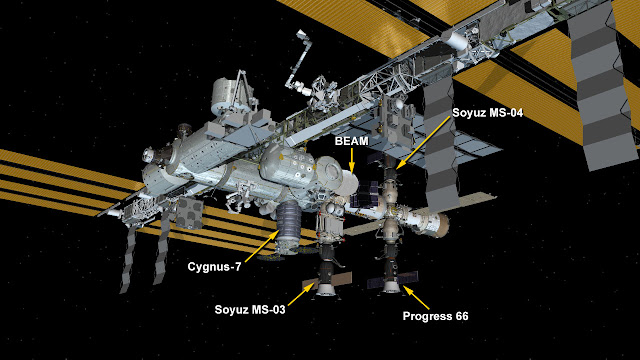Orbital ATK - CRS-7 mission patch.
April 22, 2017
The Orbital ATK Cygnus cargo ship was bolted into place on the International Space Station’s Earth-facing port of the Unity module at 8:39 a.m. EDT. Crew will ingress the spacecraft later today. The spacecraft will spend about three months on station before it is released in July for a destructive re-entry into the Earth’s atmosphere, disposing of several thousand pounds of trash.
Image above: The Orbital ATK Cygnus cargo craft approaches its 10 meter capture point where the Canadarm2 grapples resupply ship. Image Credit: NASA TV.
Using the International Space Station’s robotic Canadarm2, Expedition 51 Flight Engineer Thomas Pesquet of ESA (European Space Agency) and Commander Peggy Whitson successfully captured Orbital ATK’s Cygnus cargo spacecraft at 6:05 a.m. EDT. The space station crew and robotic ground controllers will position Cygnus for installation to the orbiting laboratory’s Earth-facing port of the Unity module.
U.S. Commercial Cargo Ship Arrives at the International Space Station
The spacecraft’s arrival brings more than 7,600 pounds of research and supplies to support Expedition 51 and 52. Some of the research on board includes:
- In microgravity, cancer cells grow in 3-D, spheroid structures that closely resemble their form in the human body, enabling better tests for drug the efficacy. The ADCs in Microgravity investigation tests drugs designed as targeted cancer therapies called antibody-drug conjugates, developed by Oncolinx.
- The Solidification Using a Baffle in Sealed Ampoules (SUBSA) investigation originally was operated successfully aboard the station in 2002. Updated software, data acquisition, high definition video and communication interfaces will help advance understanding of the processes involved in semiconductor crystal growth. Investigations such as the CLYC Crystal Growth experiment will be conducted in the SUBSA Furnace and inserts. High-quality crystals are essential to a variety of applications, and a microgravity environment can produce better quality crystals.
- The Thermal Protection Material Flight Test and Reentry Data Collection (RED-Data2) investigation studies a new type of recording device that rides alongside a spacecraft as it reenters Earth’s atmosphere, recording data about the extreme conditions it encounters. Scientists, so far, have been unable to monitor those conditions on a large scale, and a better understanding could lead to more accurate spacecraft breakup predictions, better spacecraft designs, and materials capable of better resisting the extreme heat and pressure during the return to Earth.
Image above: Four spacecraft are parked at the station including the Orbital ATK Cygnus resupply ship, the Progress 66 cargo craft and the Soyuz MS-03 and MS-04 crew vehicles. Image Credit: NASA.
Prior to re-entry in late July, the Cygnus spacecraft will also host the third Spacecraft Fire Experiment, or SAFFIRE, to study how fire burns in microgravity. Data from these experiments will help inform the development of future crew spacecraft.
Related links:
ADCs in Microgravity: https://www.nasa.gov/mission_pages/station/research/experiments/2347.html
Solidification Using a Baffle in Sealed Ampoules (SUBSA): https://www.nasa.gov/mission_pages/station/research/experiments/316.html
CLYC Crystal Growth: https://www.nasa.gov/mission_pages/station/research/experiments/2353.html
Reentry Data Collection (RED-Data2): https://www.nasa.gov/mission_pages/station/research/experiments/2205.html
Space Station Research and Technology: https://www.nasa.gov/mission_pages/station/research/index.html
International Space Station (ISS): https://www.nasa.gov/mission_pages/station/main/index.html
For more information about Orbital ATK, visit: https://www.orbitalatk.com/
Images (mentioned), Video (NASA TV), Text, Credits: NASA/Mark Garcia.
Best regards, Orbiter.ch



